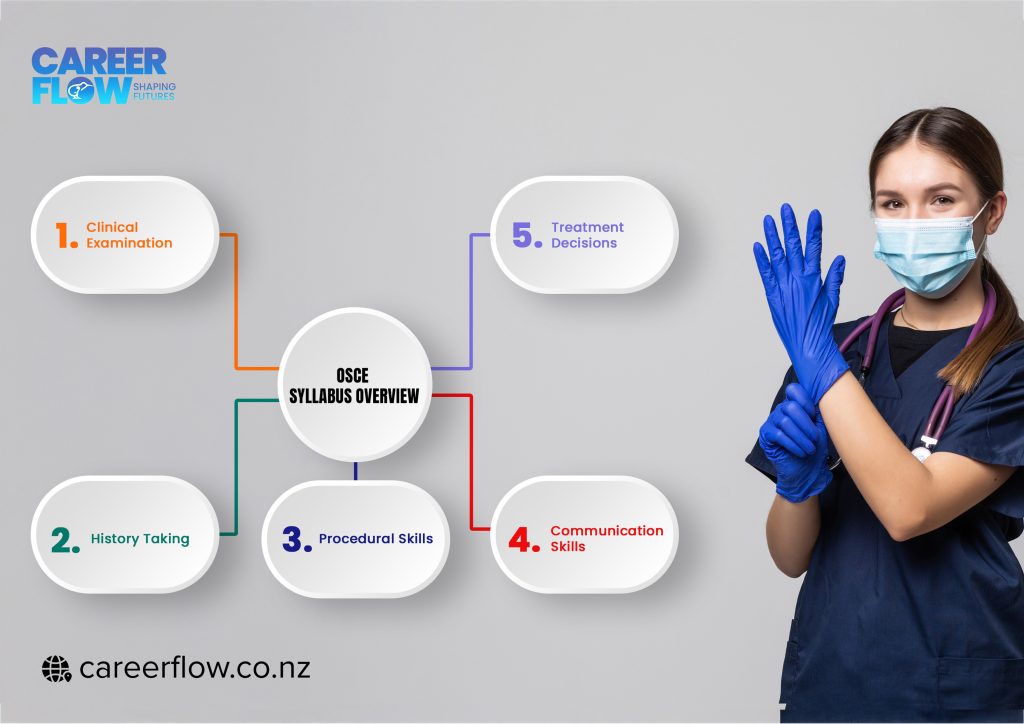Feeling overwhelmed by the OSCE? You’re not alone. The Objective Structured Clinical Examination is a significant milestone in your medical journey, and understanding what to expect can make all the difference. In this comprehensive guide, we’ll walk you through the OSCE exam format and syllabus, offering practical tips and insights to help you prepare effectively and confidently. Whether you’re just beginning or refining your skills, this guide is your go-to resource for OSCE success.

What is the OSCE?
The OSCE is designed to assess clinical competence in a controlled, practical setting. Candidates rotate through timed stations where they are tested on key clinical skills, such as:
- History taking
- Physical examination
- Procedural tasks
- Communication skills
- Clinical decision-making
Each station simulates a real-world scenario, offering a naturalistic but standardized way to evaluate a wide range of essential skills. It is a cornerstone of medical and healthcare professional training, ensuring candidates are ready to provide high-quality patient care.
OSCE Exam Structure
The OSCE typically consists of several stations, each focusing on a different clinical scenario or task. Here’s how it’s organized:
1. Clinical Skills Stations
Evaluate your ability to perform physical exams, take patient histories, and carry out clinical procedures. For example:
- Cardiac or respiratory examination
- Wound dressing
- Injection administration
2. Communication Skills Stations
Test how you interact with patients. You may be asked to:
- Explain a diagnosis or procedure
- Deliver bad news
- Provide health education
3. Decision-Making Stations
Assess your ability to evaluate clinical situations and make appropriate decisions. You may need to:
- Develop a management plan
- Prioritize clinical actions
- Interpret investigation results
Timing and Flow
Each station typically lasts 5–10 minutes, and candidates move through the stations in sequence. This format ensures a comprehensive, time-bound evaluation of practical skills.
OSCE Syllabus Overview
The OSCE covers a broad range of clinical competencies, which typically include:
1. Clinical Examination
Perform thorough, system-based physical exams (e.g., cardiovascular, respiratory, abdominal). Know the standard techniques and be able to interpret findings accurately.
2. History Taking
Gather detailed patient histories, including presenting complaints, past medical conditions, family and social history, and medication use.
3. Procedural Skills
Demonstrate competency in essential clinical procedures such as:
- Injections
- Venipuncture
- Basic life support
4. Communication Skills
Explain procedures, reassure patients, and manage sensitive discussions empathetically and effectively.
5. Treatment Decisions
Evaluate clinical information to make appropriate and timely decisions regarding diagnosis, treatment, or next steps in patient care.
How the OSCE is Conducted
Station Format
Each station represents a unique scenario or skill. One might involve taking a patient’s history, while another tests your ability to perform a procedure or communicate effectively.
Timing
Strict time limits ensure that you complete tasks efficiently without compromising accuracy. Time management is key.
Scoring
Candidates are assessed using detailed checklists that focus on specific performance criteria in each station. The scoring ensures fairness and objectivity across all candidates.
Tips for Effective OSCE Preparation
- Understand the Exam Format
Familiarize yourself with the number and type of stations. Review any guidelines provided by the examining body. - Practice Clinical Skills
Regularly practice examinations and procedures using checklists and mock scenarios. - Strengthen Communication
Work on explaining procedures clearly and showing empathy in patient interactions. - Use Sample Questions
Practice with realistic OSCE scenarios to build familiarity and confidence. - Create a Study Schedule
Develop a balanced study plan that includes theory, practice, review sessions, and mock exams. - Get Feedback
Participate in mock exams and ask tutors or peers for constructive feedback to identify and work on weak areas.
Recommended Study Materials
- Textbooks & Guides: Use clinical examination guides and OSCE-specific prep books to cover the full syllabus.
- Online Resources: Explore video tutorials, sample scenarios, and interactive tools.
- Workshops: Attend hands-on clinical skills workshops for practical experience and expert feedback.
Importance of Mock Tests
Mock OSCEs are invaluable for preparation. They simulate real exam conditions, helping you:
- Build Exam Readiness: Practice under timed conditions to improve speed and accuracy.
- Evaluate Your Performance: Identify strengths and areas needing improvement.
- Receive Feedback: Gain insights from instructors and peers to refine your skills.
Conclusion
Preparing for the OSCE might seem daunting, but with the right approach, you can enter the exam with confidence. Think of it not just as a test, but as an opportunity to demonstrate your readiness to deliver safe, competent, and compassionate patient care.
Take it step by step. Trust your training. Believe in your abilities.
You’ve got this. Good luck on your OSCE journey!
Categories
Latest Posts

New Zealand Increases Work Hours for Int July 16, 2025

Psychiatry OSCE Cases: Common Scenarios July 12, 2025

Surgical OSCE Stations: What You Must Kn July 7, 2025
Recent Comments
Archives
Tags
Calendar
| M | T | W | T | F | S | S |
|---|---|---|---|---|---|---|
| 1 | 2 | 3 | 4 | 5 | ||
| 6 | 7 | 8 | 9 | 10 | 11 | 12 |
| 13 | 14 | 15 | 16 | 17 | 18 | 19 |
| 20 | 21 | 22 | 23 | 24 | 25 | 26 |
| 27 | 28 | 29 | 30 | 31 | ||
